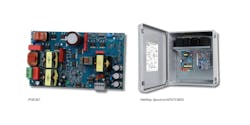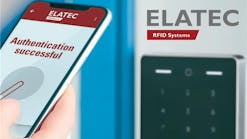Security industry forecasts all indicate that the two strongest areas of market growth for the security industry will be video surveillance and access control. Market growth means more than the total number of dollars that will be spent. It means that along with requests for upgrades to existing systems, customers who had not previously wanted access control will be looking for solutions.
While the major media reports on the mega systems and global projects, most locksmiths are selling access control a door or two at a time. And although many of us have the technical knowledge for giant projects, most of our customers are looking for inexpensive and easy to operate solutions, not insurmountable cyber-challenges with huge price tags.
That’s why Dortronics came out with the 8960 EZ-Access System. Dortronics knows that in between your major projects, you need a product that will satisfy the other 99 percent of your customers, and you might as well use theirs.
The 8960 has some very attractive features, and seems to have been designed with the typical end-user’s most frequently requested features in mind.
The controller can support two separate openings each with a reader; or a single opening with entry/egress readers; or two openings with a single reader. Since the unit has two controllable relays as well as a controllable auxiliary output, you have several options for custom applications.
The 8960 is classified as a standalone access control, because it does not connect to a network to operate. It requires 12 VDC which can be easily arranged with a plug-in transformer.
It also requires an electric locking device, which can be just about anything you want. For example since it is suitable of outdoors as well as indoor applications, you could operate a gate operator for parking control applications.
A card reader and/or keypad is required. Typically one for each opening, although one keypad could be ostensibly used to control two doors. The 8960 uses 26 bit Wiegand interface between the reader and the controller; the defacto protocol for reader to controller connections.
The 8960 has a 2,000-credential capacity, and a 2,000-event audit trail.
The 8960 can be deployed and programmed without a computer. However, the 8960 will communicate via USB with a PC for generating an activity log. This is a helpful diagnostic aid if you’re troubleshooting, and it costs the end-user and installer nothing extra to use except for the purchase of the software.
Q & A: BRYAN SANDERFORD
Locksmith Ledger got EZ Access product specifics during a recent interview with Bryan R Sanderford, National Sales Manager, Dortronics Systems, Inc. Following are Ledger’s questions and Sanderford’s answers. Must EZ-Prox credentials be used with the system?
The proprietary format EZ-Prox readers will only operate with EZ-Prox cards and key fobs to maintain the highest level of security. However, other 26-bit Wiegand proximity readers with matching cards or Wiegand compatible keypads may be used with the EZ-Access controllers if needed.
How does the EZ-Logger software associate cards with cardholders?
The EZ-Logger software is only used to extract an audit trail. To provide an easy-to-utilize history report, this software allows user names to be associated with cards that have been enrolled for the controller. This software also provides data fields for name, card number, and card holder group name. The EZ-Logger software is also utilized to set the time and date in the controller to provide the time and date stamp of each transaction.
So credentials are enrolled manually, but the system can print out the list of valid credentials in memory?
The EZ-Access system is a true off-line, standalone access control system. A computer and software is not required to operate the system. User cards and PINs are programmed into or out of the system utilizing a unique programming card. Once the user IDs have been enrolled in the system, the cardholder data (name, card or tag ID and associated group such as maintenance, sales, technician, etc.) are entered manually in fields provided by the EZ-Logger software to allow an easy-to-read audit report. Fields containing cardholder data are maintained as a single record by the application on the computer used to download transaction history. An edit function is provided to update the data when required. The data entered can be used to report valid card holders and associated activity (audit trail).
How are the two relays assignable?
The relays are configured to operate with the reader devices by jumpers on the controller. One reader may operate one relay each in a standard two independent door system or both readers operating relay-1 for an “in/out” configuration. The EZ-Logger software allows a unique three-character designator to be associated with each reader to report user activity as being at door “01”, door “02” or “IN” door / “OUT” door.
How is the aux output assignable?
The OP3 terminal may be connected to an auxiliary (off-board) relay or can be used to provide a signal to other logging or monitoring systems. A signal is generated at OP3 whenever either relay (1 or 2) is activated by a card reader, keypad or REX device. A typical application would be to trigger a CCTV camera with DVR to create a visual record of each entry.
What does the door sensor do?
The Door 1 and Door 2 inputs are to monitor door openings for anti-tailgating. After an authorized unlock action, the opening of the door will cause the electric lock to re-lock, re-securing the portal immediately upon door closing. When a door open signal is detected, the transaction is logged and the unlock timing cycle is ended (relay is reset) regardless of the duration programmed (factory default is three seconds). If door switches are not used, such as a vehicle gate application, the door inputs have no function. (It is not necessary to jumper this input as the controller will be configured automatically for this option upon initial start-up of the controller.)
Is door propped or forced door alarm output available?
This being an off-line system, there is no provision for this function. However, if needed, the Dortronics #7281-EA Exit Alarm or the #7286-PT5 Door Prop Alarm can be utilized with the EZ-Access system for this use.
If two readers are used for single door, does the system differentiate which reader was used in the activity log?
Yes, each reader may be given a unique ID in the database. When a reader is activated, that reader is identified by the assigned ID for all associated transactions.
What is the file format of the log?
The user can choose between .TXT format or CSV (Comma Separated Variable) format in the SETTINGS menu. The report can be edited and/or formatted using a text editor such as Notepad. The report can be imported by any database or spread sheet application, such as Excel, that recognizes CSV format.
In addition, the report file can also be saved as an ANSI file (default), Unicode or UTF-8 from the REPORT menu in EZ-Logger. Once the file has been imported into Excel or Word, the data can be reformatted to match the user’s requirements.
What other events are reported on the activity log?
The activity log reports the transaction number, the card/tag/user ID number, the assigned card holder name, the date and time of the activity, and the reader ID.
Can a computer be connected permanently, and reports requested from the PC?
No, whenever the USB cable is connected between the controller and a computer, the controller relays are inhibited. A computer is totally unnecessary for access control operation. The computer is only needed if a history report is ever required. A permanent computer connection would negate the benefits of a small, inexpensive standalone system.
What are the rules pertaining to PIN codes, code lengths, and digit repetitions?
When adding users to the system, the entry of a duplicate code is ignored. If using keypads, PINs from 01 – 09 are reserved and cannot be assigned to a PIN holder. Any other combination of up to seven digits may be used for a PIN.
PIN codes can be added or deleted from the keypad, but a special device is required to delete credentials?
The EZ-Access system is a stand-alone offline access system. Therefore all card PIN additions and deletions are by means of a master programming card. One card marked “PROGRAM CARD” is shipped with each controller/software package. While the program card is typically used to initialize the system, actually the first card or PIN read by the controller is stored as the “master programming key.” As each controller is totally independent, it is possible for several controllers on the same site to share the same unique “master” card/code.
To delete credentials, the “master” card/code is presented (twice within 3 seconds) to a reader/keypad to cause the controller to enter the programming “delete” mode. Each card or PIN presented to the reader/keypad while in the “delete” mode is removed from the authorized user list. If a card or tag has been stolen, the EZ-Access card simulator may be used to recreate the electric signature of the lost or stolen credential. For security, the card simulator will only duplicate a user card RF signal for an addition or deletion. The controller only recognizes a true physical master card presentation to enter into the programming mode.
Tim O'Leary
Tim O'Leary is a security consultant, trainer and technician who has also been writing articles on all areas of locksmithing & physical security for many years.





